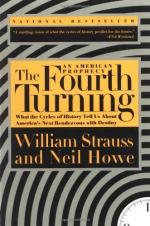
|
| Name: _________________________ | Period: ___________________ |
This test consists of 15 multiple choice questions and 5 short answer questions.
Multiple Choice Questions
1. What comprises the First Turning according to the authors?
(a) The people destroy their health.
(b) The people strengthen civic institutions.
(c) The people wreck communities.
(d) The people become educated.
2. What did the Silent Generation wear?
(a) Expensive clothing.
(b) Loud colors and makeup.
(c) Gray flannel suit.
(d) Jeans.
3. What do midlifers do in the general cycle of life according to the authors?
(a) Look toward retirement.
(b) Raise children.
(c) Wield power.
(d) Increase religious study.
4. During the First Turning, why did Americans become conformists?
(a) Their confidence.
(b) Their new technology.
(c) Their lack of money.
(d) Their overly-educated youth.
5. What do gray champions do to the Fourth Turning?
(a) Close the Fourth Turning.
(b) Create conflict in the Fourth Turning.
(c) Bring the Fourth Turning to a climax.
(d) Grow relationships during the Fourth Turning.
6. Eventually, what happens to circular cycles?
(a) They become stronger.
(b) They have a moment of discontinuity.
(c) They disappear.
(d) They bore people.
7. Who controlled much of the world during the First Turning?
(a) The GI Generation.
(b) The Lost Generation.
(c) The Silent Generation.
(d) Generation X.
8. How does each generation experience each period of the cycle?
(a) Every second year since its development.
(b) In harmony and cooperation.
(c) Different but tightly correlated stages of development.
(d) With great discord.
9. What do cycles in major cultures share according to the authors?
(a) A changing of clothing styles.
(b) An idea of a male God.
(c) They follow several rules.
(d) A change in transportation.
10. What were Jon Edwards and William Lloyd Garrison considered?
(a) Artists.
(b) Nomads.
(c) Heroes.
(d) Prophets.
11. What is a 'saeculum' according to the authors?
(a) The despair in communities.
(b) The most recent cycle.
(c) A utopia.
(d) A history that people ignore.
12. What is the authors' fear as the book opens?
(a) The country is unraveling.
(b) People will not seriously read the book.
(c) History is being rewritten.
(d) Americans will not vote.
13. In determining a generation, what should one look for according to the authors?
(a) Common beliefs and behaviors.
(b) Birth rates.
(c) New transportation and styles.
(d) Athletic patterns.
14. Where do seasons occur according to the authors?
(a) Outdoors, four times a year.
(b) Across and within generations.
(c) At historical museums.
(d) Within the education system.
15. What was the clash of powerful personalities during the beginning of Anglo-American modernity?
(a) The Allies and the Axis powers.
(b) Wars of the Roses and the Protestant Reformation.
(c) Europe and America.
(d) The North and the South.
Short Answer Questions
1. When a time period produces a revolutionary change, what stage are the 'heroes'?
2. What do all major cultures acknowledge according to the authors?
3. How do generations behave with the concept of 'acting according to your season' according to the authors?
4. How do generations often define themselves according to the authors?
5. What fascinated the Romans according to the authors?
|
This section contains 512 words (approx. 2 pages at 300 words per page) |

|




